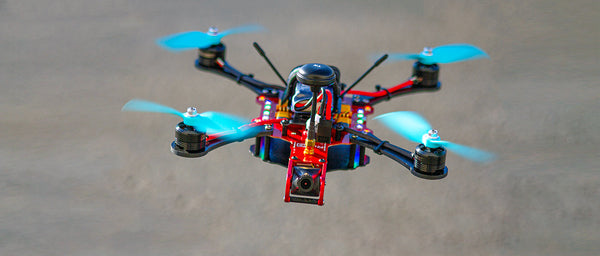
With the Sport of the Future
There’s no denying it — the vast potential of unmanned aerial operations has whipped in-and-out of our daily lives, bringing with it vocational innovation and industry evolution. The STEM careers of tomorrow are being supercharged with the help of drones. But, the job market isn’t the only sector of our lives affected by UAVs.
Drones are taking over the World of Recreation, with drone racing quickly solidifying itself as the sport of the future.
What is Drone Racing?
What is drone racing, you ask? Well, since the earliest days on the Earth, humans have loved to compete. We moved from foot races to horses, chariots to bicycles and from Model T’s to Formula 1 all with one purpose in mind — making opponents eat our dust. There is something so deeply human about winning a race, about having your arm raised as the victor, that our instincts jumped at the opportunity for a new competition. Our need-for-speed has crossed another threshold, leaping into the air.
Drone racing started simply in Australia in late 2014, with pilots facing off against each other to see who could complete a course lap in the fastest time. Since then, the sport has evolved considerably. There are leagues, ESPN races and high-octane contests held all over the world. In a race, pilots must use their quadcopter to navigate a designated course, one with air-gates and flags to fly through and around, all in an effort to shave precious seconds off of their previous lap time — oh, and did I mention that they’re doing this all while piloting from the cockpit of the drone? Well, essentially from the cockpit. Using FPV transmitters and cameras, the pilots see what their drone sees in real time, allowing them to make pinpoint, harrowing turns, flips and aerial maneuvers.
With many UAVs reaching top speeds over 100mph, drone racing is like modern day pod racing.

Hosting spectacular crashes and incredible competitive skill, the sport of drone racing has started capturing the hearts of the world — and for more reasons than their affinity for making you stop and say, “wow.”
Getting Started
Drones have also bridged the gap between manipulative-based racing and the spectator. In Nascar and Formula 1, motorized sport has always been a far-fetched dream of those looking for their high-octane fix. Remote controlled cars tried to bring racing to the hobbyists, but with a small market and even smaller racing base, these micro-cars have only managed to carve out a niche in the racing sector. Drones, however, have done what remote controlled cars never could — they’ve provided audiences and spectators with a product and competition readily available to them.  The only thing separating a pilot at the national drone racing championships from someone sitting in the stands is how quick their lap time was during the qualifier. As self-built, engineered and modified aerial machines, drone racing can be easily accessed by anyone looking to take up the sport. With drones ready-to-fly out of the box — UAVs you can quite literally take to the race, open the box and win with — like the Riot 250R Pro, the only thing that separates pilots from one another is their piloting skill level. Sure, there are modifications that can be made to the drones, little tweaks, and twists, but wholly, drone racing has offered humans a chance to return to their competitive instincts, and hundreds of thousands of pilots are jumping at the chance.
The only thing separating a pilot at the national drone racing championships from someone sitting in the stands is how quick their lap time was during the qualifier. As self-built, engineered and modified aerial machines, drone racing can be easily accessed by anyone looking to take up the sport. With drones ready-to-fly out of the box — UAVs you can quite literally take to the race, open the box and win with — like the Riot 250R Pro, the only thing that separates pilots from one another is their piloting skill level. Sure, there are modifications that can be made to the drones, little tweaks, and twists, but wholly, drone racing has offered humans a chance to return to their competitive instincts, and hundreds of thousands of pilots are jumping at the chance.
From a family hobby to the quest for a gold medal, all it takes to start your racing career is a drone.  Then, it’s time to find a race. Rather than scouring the newspaper and badgering your local hobby store, this is where MultiGP Drone Racing steps to the plate. MultiGP is the world’s largest drone racing league, bringing cutting-edge race management software and thrilling events to racers around the world. They unite pilots in casual and competitive events and foster the growth of drone racing clubs all over the globe. As they say,
Then, it’s time to find a race. Rather than scouring the newspaper and badgering your local hobby store, this is where MultiGP Drone Racing steps to the plate. MultiGP is the world’s largest drone racing league, bringing cutting-edge race management software and thrilling events to racers around the world. They unite pilots in casual and competitive events and foster the growth of drone racing clubs all over the globe. As they say,
Drone racing is more than crossing the finish line first. It’s training every day to shave milliseconds. It’s the freedom of flight. It’s the countless nights spent repairing your gear for the next race. It’s the friends you make, the community of like-minded adventurers, outcasts, jocks and nerds alike. It’s growing the sport together. By pilots. For pilots.
Cornering the market as the world’s leading drone racing league, MultiGP is every pilot’s one-stop-shop for racing — and membership is free.
Bridging the Gap
Now, as we know, drones have taken the world by storm. They capture stunning aerial photography, save lives in modern day search and rescue missions, collect samples from whales for scientific research, inspect vast agricultural landscapes and thrill spectators in First-Person View (FPV) racing — but the fun doesn’t stop there.

They’re also making their way into high schools across the nation, with the unique aerial robotics platform providing students with a total STEM solution, engaging learners in challenges of engineering, physics, math, coding and more.
Drones:
- Are a highly engaging, optimized tech-ed recruiting tool.
- Invigorate learning spaces through rich STEM experiences.
- Provide hands-on training for future careers in the exploding drone industry
- Bring the technologies of tomorrow to the hands of students today!
But, there’s a problem on the horizon. On the one hand, drones are an incredibly versatile tool. They engage students in every facet of STEM, all while preparing them for the careers of the future, but how are you going to tap into the thrilling spectacle of competition that drone racing provides?

The sport of drone racing is an educational gold mine. As Docsity, an online learning platform for students says,
Competitions play a role in motivating students to perform and excel and offer a lot more reward than just the winning prize. Competitions offer a chance for participants to gain substantial experience, showcase skills, analyze and evaluate outcomes and uncover personal aptitude. Competitions also encourage students to adopt innovative techniques and develop their ideas and skills.
Very few opportunities in the average student life provide such exposure and realistic outlook towards the competitive nature of real life in such a short span of time as competitions provide. Students recurrently go through a series of brainstorming sessions, rapid problem-solving sequences and experience a totally diverse form of learning, which they usually don’t practice in their schools or colleges.
You’ve got the drone racing carrot and the knowledge hungry rabbits, and it’s nearly suppertime. So how do you bridge the gap, marrying your drone program with the incredible benefits of competition?
STEM at 75 MPH
Well, MultiGP and PCS Edventures are one step ahead of you. Realizing the need for a concrete STEM program that prepares learners for the future of unmanned aerial operations, PCS Edventures and MultiGP Racing League teamed up for the world’s first-ever high school UAV racing program, The Scholastic Drone Racing Series.
With a growing network of programs across the nation, The Scholastic Drone Racing Series couples MultiGP’s world-class race management software, skills and extensive member network and PCS Edventures’ state-of-the-art curriculum, innovative Discover Drones program and the Riot 250R Pro — a near indestructible racing drone ideal for school programs — to invigorate learning across the nation with high-octane education.
The Scholastic Drone Racing Series
The Scholastic Drone Racing League is the world’s first UAV racing league to come to Junior and Senior High Schools across the United States. While the league's development is still ongoing, this past spring, MultiGP showcased its world-class race management skill, and its ability to tap into new and incredible drone arenas with the first ever National Collegiate Championship, an FPV racing tournament held at Purdue University with over 28 other colleges. As stated in their recap:
College sports history was made last weekend with the first ever Collegiate Drone Racing Championship, which was hosted by Purdue University. MultiGP was honored to sanction and officiate this event, which was a preview of the 2018 Collegiate Drone Racing Series, scheduled to take place at colleges across the nation next year. This inaugural event drew 48 collegiate drone racing pilots from 26 colleges and universities to compete in both team and individual events, to see which school, and which pilot, were the fastest.
To learn more about the Scholastic Drone Racing Series, visit this link or contact PCS Edventures at 800-429-3110 or support@edventures.com
The Three Ribs to a Race
There are three essential parts to a drone race:
1.) Race Management Software:
MultiGP has developed proprietary software that assigns racing slots and video frequencies in real time. Pilots create a profile within MultiGP.com and then add their aircraft with their unique hardware combinations. Then, on race day, they use their smartphones and check-in when they arrive. They are assigned their race slot and optimum video frequency as to not interfere with the other pilot’s video signal. Through this software, the event director immediately knows who is in each race and what channel they are expected to transmit on. Pilots are also informed of the other pilots who will be transmitting on the same frequency throughout the day so they can manage these transfers on their own.
2.) Racing Gates:
MultiGP has developed racing gates that are simple to transport and setup. They are specific dimensions so chapters can easily accommodate sponsor panels when applicable.

3.) Timing Systems:
Racing against each other is a blast, but timing how fast you are actually finishing laps is critical to competing on a larger scale and bettering your skills. The MultiGP system is installed on the start/finish gate and automatically tracks each pilot's lap time through a small and lightweight sensor. Pilots simply install the sensor to their aircraft and all data is streamed to a laptop where it is managed appropriately.
Letting the Dust Clear
All around the world, drone racing has begun making a name for itself. Only halfway through its third birthday, it’s still but a babe, but the globe has started realizing its potential. From schools and afterschool programs to hobbyists and professional pilots, drone racing has the capacity to invigorate your students’ STEM learning far outside the reaches of the classroom. Whether it be through the Scholastic Drone Racing Series or through a backyard time-trial, UAVs are here to stay, and just as our instincts have always dictated, we will forever pit machine against machine, man against man, and competitor against competitor.
The only question that remains is, are you ready to put your foot on the starting line?


References
Docsity. (2017, August 05). How Participating In Competitions Can Benefit Your Student Life. Retrieved September 07, 2017, from https://studentcompetitions.com/posts/how-participating-in-competitions-can-benefit-your-student-life








